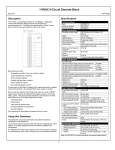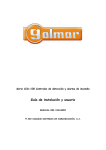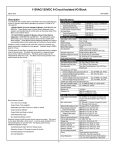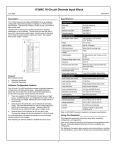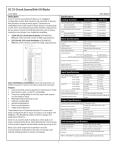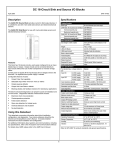Download Genius 115VAC 8-Ckt I/O Block datasheet, GFK0035D
Transcript
This Datasheet for the IC660BBD101 Block 115Vac I/O Low Leakage 8 Circuits http://www.qualitrol.com/shop/p-14434-ic660bbd101.aspx Provides the wiring diagrams and installation guidelines for this GE Series 90-30 module. For further information, please contact Qualitrol Technical Support at 1-800-784-9385 [email protected] 115VAC 8-Circuit Discrete I/O Block June 2002 GFK-0035D Description _____________________________________ Specifications _________________________________ The 115VAC Low-leakage I/O Block (IC66*BBD101) is an intelligent, configurable module that interfaces discrete sensors and actuators to a communications bus. The block has eight identical 115VAC circuits. Each circuit can be used as either an input or an output. Catalog Numbers Block Electronics Assembly Terminal Assembly Block Specifications Size (height x width x depth) Weight LEDs (I/O Block) LEDs (each circuit) Block to Block Isolation Heat Dissipation 115V 50/60 Hz In/Out Block features include: Selectable input Filter Time from 10ms to 100ms. Output feedback for monitoring. Output powerup defaults. Outputs hold last state or default. Pulse Testing for outputs. Bus Switching Module control. Control power for the block is tapped off the input/output device voltages wired to the terminals. No separate block power supply is needed. Each circuit has electronic fusing that shuts down the circuit in 5ms if output current exceeds 30 Amps with the output turned on, or 20 Amps after 2 cycles. The circuit is easily restored by command from a Hand-held Monitor or the CPU. Block diagnostics include: 8.83” (22.44cm) x 3.34” (8.48cm) x 3.91” (9.93cm) 4 lbs. (1.8 kg) Unit OK, I/O Enabled On logic side of switch 1500V 16W maximum with 8 inputs, 43.5W maximum with 8 outputs on at 2 Amps. 8.5 Watts Standby power (all inputs and outputs off) Operating voltage (single source) 93-132VAC Frequency 47-63 Hz Power supply dropout time 1 cycle (16.7ms at 60Hz, 20ms at 50Hz) Input Specifications Non-tristate input OFF state min. voltage across input device (IN to H) 60V RMS OFF state, max. leakage through input device 1.5mA ON state, max. voltage across input device (IN to H) 20V RMS ON state, max. switch current threshold 6mA RMS Tristate input OFF state, acceptable voltage across input device (IN to H) 16V RMS-40V RMS, ON state, max. voltage across input device (IN to H) 4V RMS Input load network Resistor to N: 13K Ohms Capacitor to H: 0.10 µf Input processing time (typical) 2ms + filter Selectable input filter times 10 to 100ms in 10ms increments Input diagnostics Open Wire, Overtemperature, Failed Switch Output Specifications Circuit output current (steady state) 2 Amps RMS Max. inrush current up to 2 cycles 25 Amps peak Maximum inrush current 2-6 cycles 14 Amps peak Maximum block output current 15 Amps at 35°C, 7.5 Amps at 60°C Output Leakage @ 115 VAC Current at 0 volt output (OUT to N): < 7mA Voltage at open output (OUT to N): 65 volts Output switch Zero crossing (OFF to ON/ON to OFF) Maximum switching frequency once per second (high inrush currents) Turn-on delay 0.5 Hz + 1ms, maximum Voltage drop 2.5V at 2 Amps, 10V at 30 Amps inrush Recommended min. load (No Load 25mA resistive, 40mA inductive disabled) No Load enabled threshold 50mA Fusing Internal electronic short circuit trip. 100ms long time trip Output diagnostics Short Circuit, Overload, No Load, Failed Switch, Overtemperature Environmental Specifications Operating temperature 0° C to +60° C (+32° to +140° F) Storage temperature -40° to +100° C (-40° to +212° F) Humidity 5% to 95% (non-condensing) Vibration 5-10 Hz 0.2” (5.08mm) displacement, 10-200 Hz at 1G Features IC66*BBD101 IC66*EBD101 IC66*TSD100 Overtemperature Failed Switch Open Wire for tristate inputs Overload Detection and Shutdown No-load Detection Fault reporting can be enabled or disabled circuit by circuit. Using this Datasheet ____________________________ This datasheet summarizes information about block installation, configuration, and diagnostics. Your primary reference should be the Discrete and Analog Blocks User’s Manual. It includes detailed instructions for block installation and configuration. For additional information about systems and communications, including bus specifications, refer to the I/O System and Communications Manual. Refer to GFK-0867 for product standards and general specifications. 1 115VAC 8-Circuit Discrete I/O Block June 2002 GFK-0035D Compatibility __________________________________ This block is fully compatible with Hand-held Monitor model IC66*HHM501. It may be used with IC66*HHM500; however, HHM501 is required to change the baud rate or to configure the block for redundancy. 1. Unscrew the retaining screws at the top and bottom of the block. 2. Using a Block Puller (IC660BLM507), engage the tabs in the first vent slots. Move the tool to the center of the block and squeeze the handle. 3. Pull the Electronics Assembly upward. Warning If the block will be used on a bus controlled by an IC550 series PLC, or a host computer equipped with a bus interface module, and the block will be configured as an inputs-only block, it may be necessary to upgrade the IC550 bus controller or computer bus interface module as detailed in the Discrete and Analog Blocks User’s Manual. If power is applied to the field terminals, power is also exposed on the connector pins at the base of the Terminal Assembly, and electrical shock hazard exists. Do not touch the connector pins! Death or injury may result. Block IC66*BBD101 is designed to control small loads without the addition of parallel load resistance. It is also suitable for installations where a Class 1 Division 2 rating is required for Factory Mutual. Inserting an Electronics Assembly 1. This block is backward compatible with blocks IC66*CBD100 and BBD100, and may be used to replace them. Electronics Assembly IC66*EBD101 replaces IC66*ELD100 and EBD100. Terminal Assemblies IC66*TSD100E and later are not compatible with earlier versions of the Electronics Assembly. If the Terminal Assembly will be used to replace Terminal Assembly IC66*TSD100D or earlier, the Electronics Assembly must be either replaced with version IC66*EBD101F or later, or upgraded. Align the Electronics Assembly in the guides and push down firmly. Caution Do not exert excessive force; it may damage the block. 2. If unusual resistance is met, remove the Electronics Assembly. If power is applied to the block, DO NOT TOUCH THE CONNECTOR PINS! Inspect the Terminal Assembly, connector receptacle, and connector edge board (on the Electronics Assembly). Be sure the keying matches. Remove any obstacles and reinsert the Electronics Assembly. Pay close attention to the alignment of the guide pins. 3. Secure the Electronics Assembly with the screws on the top and bottom of the Terminal Assembly. Installation Instructions ___________________________ Carefully inspect all shipping containers for damage. If any equipment is damaged, notify the delivery service immediately. Save the damaged shipping container for inspection by the delivery service. After unpacking the equipment, record all serial numbers. Save the shipping containers and packing material in case it is necessary to transport or ship any part of the system. Grounding The block’s mounting screws must not be used as the only means of grounding the block. Connect the green ground screw on the block to a reliable ground system using a short wire lead, minimum size AWG #12 (avg 3.3mm2 in cross-section). Block Mounting Genius I/O blocks are considered "open equipment" and therefore must be installed within a protective enclosure. They should be located in an area that is clean and free of airborne contaminants. There should be adequate cooling airflow. Warning If mounting screws do not make good ground connection and the ground screw is not connected to a reliable ground, the block is not grounded. Electrical shock hazard exists. Death or personal injury may result. The block can be mounted right side up, or upside down. Leave at least 2 inches of space between blocks. Mount the block by drilling two screw or bolt holes for 8-32 hardware. Position the block so that the notches in the upper and lower flanges line up with the mounting holes. Mount the block using 8-32 screws. Use star washers to provide ground integrity. Block Wiring __________________________________ All terminals accept one AWG #12 wire (avg 3.3mm2 cross-section) or two AWG #14 wires (each avg 2.1mm2 in cross-section). The minimum recommended wire size is AWG #22 (avg .36mm2 in cross-section). Removing an Electronics Assembly Block terminals can also accommodate spade or ring terminals up to 0.27 inch (6.85mm) wide with a minimum opening for a #6 screw, and up to 0.20 inch (5.1mm) depth from the screw center to the back barrier. Be sure unshielded wire ends are not longer than 2 inches (5 cm). The block’s Electronics Assembly can be replaced with a compatible model without removing field wiring or reconfiguring the block. Electronics Assembly Do not overtorque the terminal screws. Recommended torque for all terminals is 6 in/lb (.678 N/M). Retaining Screws (Qty. 2) Terminal Assembly Connector Pins 2 115VAC 8-Circuit Discrete I/O Block June 2002 GFK-0035D Connect a 115 volt AC source to one of the H terminals on the terminal strip. Connect neutral to an N terminal. All H terminals are internally bussed, as are all N terminals. Extra power terminals are for convenience. Depending on the physical layout and current loads, hot connections can be bussed together and made by one wire to the block or power source. Neutral connections can also be bussed together and made by one wire. Serial Bus Wiring Terminals 1 to 4 are for the serial bus. If the block will be used as a BSM Controller, first install the Bus Switching Module at the block’s serial bus terminals. Then connect the serial bus cables to the BSM terminals, as described in the Bus Switching Module datasheet. Wire either of the BSM’s pigtail wires to terminal 10. Connect the second BSM wire to an N terminal. Any circuit can be an input or output. Connect the power source through the input device (such as a switch) to a discrete input circuit on the block. For outputs, power is routed through the block electronics to a discrete circuit and applied to a load. Connect the load return to the N terminal. Make all power connections on the block to the same 120 VAC phase. Different blocks can have different phases between them. Using one of the cable types recommended in the System and Communications User’s Manual, connect the serial bus to terminals 1- 4. BLOCK 1 BLOCK 2 115 VAC PHASE 1 1 SERIAL 1 2 SERIAL 2 3 SHIELD IN 4 SHIELD OUT INPUT DEVICE OUTPUT DEVICE If the block is at either end of the bus, connect a terminating resistor of the appropriate type (see the System and Communications User’s Manual for details) across its Serial 1 and Serial 2 terminals. Start of Bus OUTPUT DEVICE N H N N Power Disconnects Since block power is the same as circuit power, it is important to wire block power disconnects so that block power and input power will be removed at the same time. Terminating Resistor POWER DISCONNECT AC BLOCK YES NO Serial 1 Serial 2 Shield In Shield Out Serial 1 Serial 2 Shield In Shield Out INPUT DEVICE N End of Bus Terminating Resistor 115 VAC PHASE 2 H H ~ If you want to disable the block without removing power from input devices, use a Block Puller to unplug the Electronics Assembly. Do not disconnect H or N to remove power. LOAD N Caution If I/O circuit power is not removed at the same time as block power, the block may power up when multiple inputs are activated, even though one leg of power has been removed from the block. Field Wiring Connect wiring for I/O devices to terminals 10 - 17. Connect twowire output devices to N, and two-wire input devices to H, as shown below left. Connect three-wire devices as shown below right. Wiring for Tristate Inputs Output Signal (hot not used) Neutral N Typical Output Device Wiring (10-17) N DEVICE 1 H N DEVICE 2 H N DEVICE 3 H N DEVICE 4 H N DEVICE 5 H N DEVICE 6 H N DEVICE 7 H N DEVICE 8 H Input Signal (10-17) H (neutral not used) Typical Input Device Wiring H AC Power Source ~ N Note: Terminals 5-9 and 18-22 are connected in the Terminal Assembly 5 H 6 H 7 H 8 H 9 H 10 1 11 2 12 3 13 4 14 5 15 6 16 7 17 8 18 N 19 N 20 N 21 N 22 N If an input circuit should report open wire conditions, install a 5.1K ohm, 1/2 Watt or larger non-inductive resistor across the dry contacts of the input device. The circuit must be configured as a Tristate Input. H IN ~ N External Suppression If a contact is wired between the block and a load, install suppression across the load. Resistor capacitor suppressors are preferred for low current, high inductance loads. For a high-power load, instead use a voltage-clamping device such as a MOV. RC suppressors are also recommended to reduce electromagnetic interference. Power supply-side switches may require line to line suppression if power is to be switched with devices energized. See the Discrete and Analog Blocks User’s Manual for more information about using suppression. 3 115VAC 8-Circuit Discrete I/O Block June 2002 GFK-0035D Diagnostics ____________________________________ Block Operation ________________________________ Block diagnostics are listed below. Overload and No Load reporting are optional features that can be disabled during block configuration. The 115VAC Low-leakage I/O block has eight identical circuits rated to operate at a nominal 115 volts AC. It can be used as combination input/output, inputs-only or outputs-only block. Open Wire: Voltage, but no current on tristate input. Overtemperature: Block’s internal temperature is above 100° C. If the block is configured as a combination block, circuits can be any mix of inputs and/or outputs. The actual state of each output circuit will be returned to the CPU in the corresponding input reference location. The CPU can monitor the feedback state to verify (after an appropriate delay) that the output switching device has operated properly and that the load has the proper voltage and current applied. Short Circuit: Instantaneous current on an output exceeds 30A during first two line cycles or 20A thereafter. Output is turned off automatically. Overload: A load exceeds 2.8A (2.0A RMS) continuously for 100ms. Output is turned off automatically. No Load: Load does not continuously draw 50mA from the output circuit. If the block is configured as an inputs-only block, all circuits must be regular inputs or tristate inputs. Failed Switch: May mean output’s internal feedback state does not match its commanded state. False Failed Switch diagnostics may be reported if an external device like a manual switch is wired in parallel with an output. Several other Failed Switch faults may be reported on inputs and outputs, indicating a need to replace the Electronics Assembly. If the block is configured as an outputs-only block, all circuits must be outputs; no feedback analysis will be performed. Each circuit has its own LED. If the circuit is used as an input, the LED indicates the presence of threshold voltage at the input terminal. If the circuit is used as an output, the LED indicates the state commanded by the CPU. Configuration _________________________________ First, the block must be configured with a Hand-held Monitor to: 115 VAC “H” H Configured as an Input * Input Device Configured as an Output Smart Switch Processor Preload Resistor 13K Output Device Terminal Assembly Internal Circuits Feature LEDS _____________________________________ The block's Unit OK and I/O Enabled LEDs show its operating status: ON ON I/O Enabled ON OFF ON Blinking Blinking Blinking ON OFF Alternate Blinking Synchronous Blinking OFF Don’t Care In addition, unless all circuits on the block will be inputs, the Block I/O Type must be set to either Outputs or Combination on the Program Block ID screen. Note: If a block is configured offline, it must be properly grounded and have a 75 Ohm resistor installed across its Serial 1 and Serial 2 terminals. See the Discrete and Analog Blocks User’s Manual for instructions. 115 VAC “N” * .2µF for Block IC66*BBD100 .1µF for Block IC66*BBD101 Unit OK Enter its Reference Number (required only for IC600 and IC550 series PLCs only). The rest of the features can be configured either using a Hand-held Monitor, or by sending a Write Configuration datagram to the block from the host. N Field Connections Enter its Device Number (serial bus address). Internal +5V MOV 1-8 Meaning Block functioning, CPU communicating Block functioning No CPU communications for 3 bus scans Block functioning, Circuit forced Circuit fault, CPU communicating Circuit fault No CPU communications for 3 bus scans Circuit fault, Circuit forced No CPU communications - block number conflict No block power, or block faulty For each input circuit, the circuit LED indicates the presence of threshold voltage at the input terminal. Output circuit LEDs show the state commanded by the CPU. 4 Device Number Circuit / Block Block Factory Setting null Reference Address Block I/O Type Baud Rate Block Block Block Pulse Test Input Filter Time Overload Shutdown Circuit I/O Type Report Faults Hold Last State Output Default State BSM Present BSM Controller Output Default Time CPU Redundancy Duplex Default Configuration Protection Block Block Circuit Circuit Circuit Circuit Circuit Block Block Block Block Block Block none input 153.6 std enabled 20ms yes input yes no off no no 2.5 sec none off disabled Selections 0 to 31 (a number must be selected) Depends on host CPU type input, output, combination 153.6 std, 153.6 ext, 76.8, 38.4 Kbd enabled, disabled 10 to 100ms yes, no input, output, tristate input yes, no yes, no on, off yes, no yes, no 2.5 or 10 seconds none, hot standby, duplex on, off enabled, disabled





